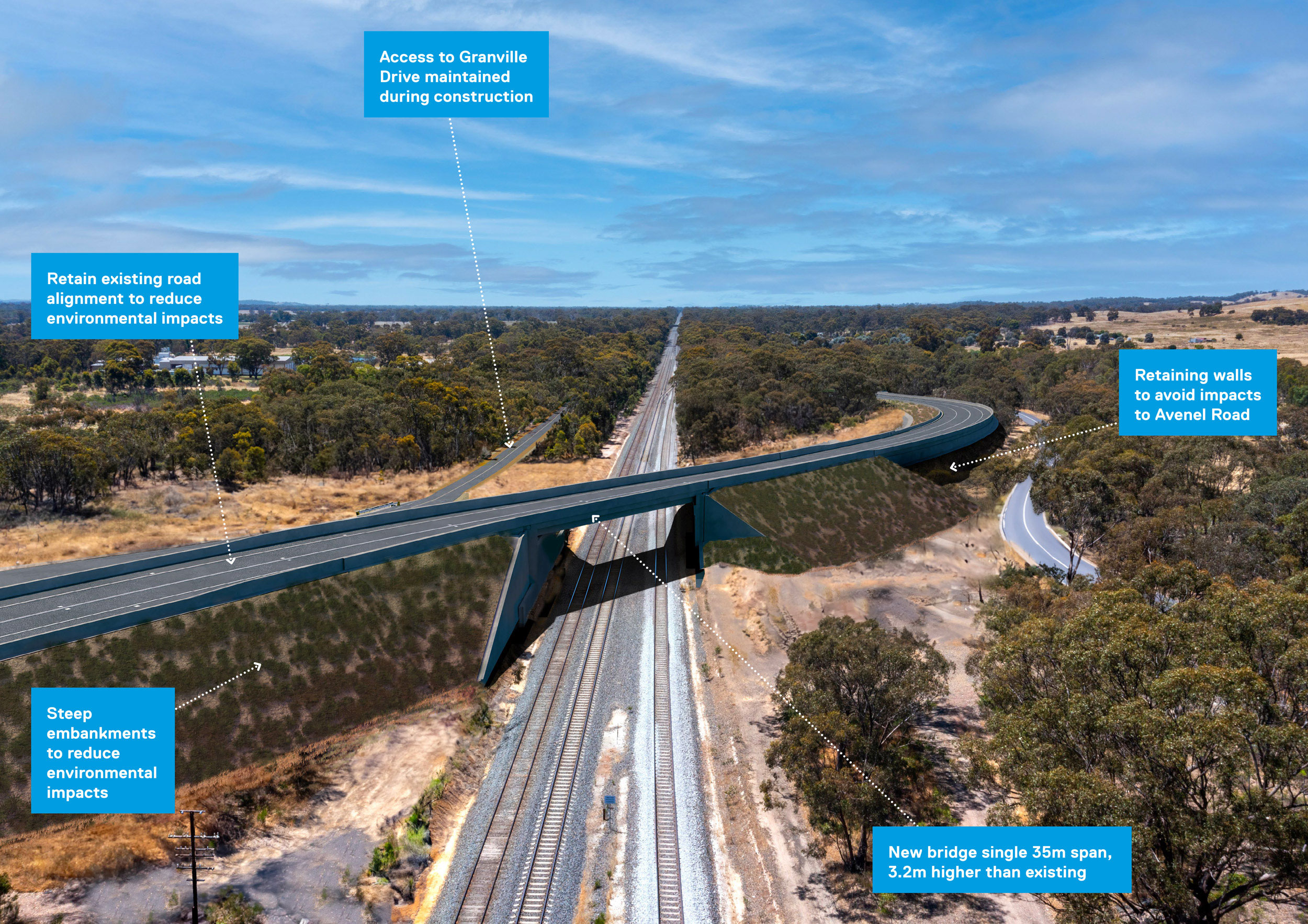Getting ready for
double-stacked freight trains

At Seymour-Avenel Road there is not enough clearance under the bridge for double-stacked freight trains. To increase clearance a new higher bridge is being built in the same location. Artist impression: courtesy Australian Inland Rail
Project Outline
- Spanning more than 1,600km, Inland Rail is the largest freight rail project in Australia and one of the most significant rail infrastructure projects in the world.
- It comprises 12 individual sections across 30 local government areas: one section in Victoria, seven in New South Wales, and four in Queensland.
- Inland Rail will upgrade 1,000km of existing rail line and build 600km of new track to connect Melbourne and Brisbane via regional Victoria, New South Wales and Queensland.
- Inland Rail will reduce traffic congestion by taking tens of thousands of large trucks off our roads each year.
- Inland Rail will cut rail freight travel time between Melbourne and Brisbane by almost a third – down from 33 hours to less than 24 hours – making it competitive with road.
- One section of Inland Rail includes construction of a 6.2km tunnel through the steep terrain of the Toowoomba Range. It will be the largest diameter diesel freight tunnel in the southern hemisphere.
- Inland Rail will provide a consistent standard gauge connection from Melbourne to Brisbane as well as a dual gauge connection in Queensland, to allow seamless connectivity with Queensland’s narrow-gauge network.
- Almost 70% of freight carried on Inland Rail will be for domestic use – that includes household goods and food.
- The track will enable the use of double-stacked freight trains up to 1.8km long, with a 21-tonne axle load and a maximum speed of 115km/h. Inland Rail will allow for the transit of greater freight volumes, with each 1.8km-long train capable of carrying up to the equivalent of 110 B-double trucks. Note: 39km of track between a proposed intermodal terminal at Ebenezer and Kagaru in Queensland will accommodate single-stacked trains only.
- Once each section of Inland Rail is completed it becomes part of ARTC’s freight rail network and enhances Australia’s supply chain. The already-completed North-West Connection at Parkes in New South Wales links Inland Rail to Brisbane, Melbourne and the East-West line to Perth – reducing the rail distance between Brisbane and Perth, and Brisbane and Adelaide, by 500km and ultimately connecting all of Australia.
Inland Rail – Victoria (Beveridge to Albury)
Inland Rail is Australia’s largest freight rail project. It will transform the way we move freight around the country by allowing double-stacked freight trains to travel between Melbourne and Brisbane via regional Victoria and New South Wales. The works required on the Victorian section of the project between Beveridge and Albury (B2A) involves modifications to some existing structures such as road bridges, signal gantries and power poles, along the existing northeast rail corridor to provide clearance for taller double-stacked freight trains to safely pass underneath. Two of the twelve sites between Beveridge to Albury are at Seymour. These sites are:
- Seymour-Avenel Road, Seymour There is not enough clearance under the Seymour-Avenel Road bridge for double-stacked freight trains. Our construction partner McConnell Dowell will replace the existing bridge with a higher bridge in the same location. The design includes a 35 metre span bridge, about 3.2 metres higher than the existing structure and incorporates earth embankments sympathetic to the surrounding environment and retaining walls to reduce impact on Avenel Road. Building a new bridge in the same location reduces our impact on the environment.
- Hume Freeway, Seymour The track will be lowered by approximately two metres under the bridge to create the space needed to allow double-stacked trains to use the line.
Would you like to know more about this nation-building project? Visit AIL's home page.